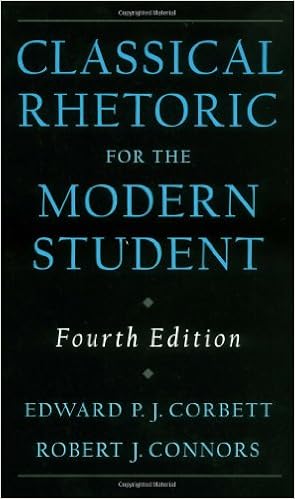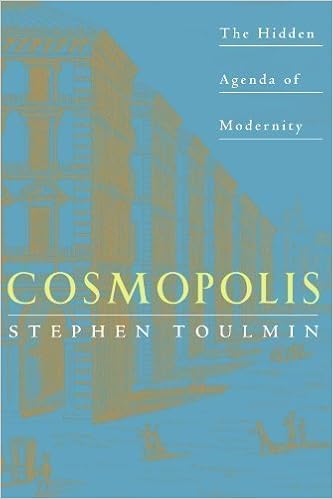
By Edward P. J. Corbett
Usual in complex composition and writing classes, Classical Rhetoric for the trendy Student discusses the 3 important elements of classical rhetoric--argument, association, and style--bringing those components to existence and demonstrating their powerful use in yesterday's and state-of-the-art writing. featuring its topic in 5 components, the textual content presents grounding within the components and purposes of classical rhetoric; the suggestions and strategies of argumentation; the potent presentation and association of discourses; the advance of energy, grace, and felicity in expression; and the background of rhetorical ideas. a variety of examples of vintage and modern rhetoric, from paragraphs to accomplish essays, seem during the ebook, many via precise analyses.
The fourth variation of Classical Rhetoric for the trendy Student contains a new part at the Progymnasmata (classical composition exercises), a brand new research of a colour commercial within the advent, an up to date survey of the heritage of rhetoric, and an up-to-date part on "External Aids to Invention."
Read or Download Classical rhetoric for the modern student PDF
Similar rhetoric books
Cosmopolis: The Hidden Agenda of Modernity
Within the 17th century, a imaginative and prescient arose which was once to captivate the Western mind's eye for the following 300 years: the imaginative and prescient of Cosmopolis, a society as rationally ordered because the Newtonian view of nature. whereas fueling awesome advances in all fields of human undertaking, this imaginative and prescient perpetuated a hidden but power schedule: the fantasy that human nature and society may be geared up into unique and potential rational different types.
Potent scholar writing starts off with well-designed lecture room assignments. In _Designing Writing Assignments_, veteran educator Traci Gardner bargains useful methods for lecturers to improve assignments that may permit scholars to specific their creativity and develop as writers and thinkers whereas nonetheless addressing the numerous calls for of resource-stretched school rooms.
Persuading People: An Introduction to Rhetoric
This interesting and sensible ebook explores persuasive suggestions within the English language, and is the fitting advent for college kids and others with a qualified curiosity in persuasion. utilizing a variety of vigorous and available illustrative fabric, Robert Cockcroft and Susan Cockcroft unpick the complexities of persuasive language - either written and spoken - and let readers to advance and improve their rhetorical talents.
- Mutuality in the Rhetoric and Composition Classroom
- Centrist Rhetoric: The Production of Political Transcendence in the Clinton Presidency (Lexington Studies in Political Communication)
- Latin Forms of Address: From Plautus to Apuleius
- The Bedford Reader
Extra info for Classical rhetoric for the modern student
Sample text
Once that aspect has been determined, the student should be prepared to formulate a thesis sentence Once the subject has been narrowed down, what does he want to say about his subject? The cardinal principle is to state the thesis in a single declarative sentence. It is important that the thesis be formulated in a single sentence. As soon as the student launches into a second sentence, he introduces foreign or subsidiary matter which is likely to violate the unity of his thesis. It is equally important to formulate the thesis in a declarative sentence.
But the councilman does not have to imagine these arguments, to think them up-to invent them, in the classical sense of that term. The second general mode of persuasion that Aristotle spoke of included artistic proof-"artistic" in the sense that they fell within the province of the art of rhetoric: rational appeal (logos), emotional appeal (pathos), and ethical appeal (ethos). In exercising the rational appeal, the speaker was appealing to his audience's reason or understanding. He is "arguing," in other words.
In exercising the rational appeal, the speaker was appealing to his audience's reason or understanding. He is "arguing," in other words. g. g. Every green apple that I bit into had a sour taste. ) In logic, the deductive mode of arguing is commonly referred to by the term that Aristotle used, the syllogism. In rhetoric, the equivalent of the syllogism was the en- 24 INTRODUCTION thymeme. The rhetorical equivalent of full induction in logic is the example. Since the next chapter will provide an elaborate explanation of syllogism, enthymeme, induction, and example, we will not dwell on them here.



